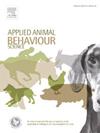Influences of environmental hatching system factors on multitasking ability and side biases in laying hen chicks hatched on-farm
IF 2
2区 农林科学
Q1 AGRICULTURE, DAIRY & ANIMAL SCIENCE
引用次数: 0
Abstract
As an alternative to conventional hatcheries, eggs can be placed in a rearing barn on day 18 of incubation (ED18; embryonic development) to hatch on-farm, which eliminates the need of transportation of day-old chicks. In addition, on-farm hatched chicks are exposed to continuous light during late incubation, and have immediate access to feed, water, and litter, which might affect developmental processes. On-farm hatching is currently not commercially implemented in the laying hen sector. However, advancements in in ovo sexing technologies are expected to enable its future adoption. Building on this context, this exploratory study aimed to examine influences of these environmental hatching system factors on the behavioral development, with focus on multitasking abilities and lateralized behavior in layer chicks until eight weeks of age. Hatching eggs (n = 600) were assigned to one of the following treatments from ED18 - ED21 (3 pens/treatment): fully enriched with all factors (ALL), continuous light (L), immediate feed and water access post-hatch (FW), immediate litter access post-hatch (LIT), or fully deprived of all factors (CON). Seventy-five focal chicks (n = 5/pen) were subjected to three behavioral tests: multitasking test at nine days of age, retention test at ten days of age, and step detour test at five and seven weeks of age. Most focal chicks did not meet the multitasking test and retention test criteria, as they did not complete the assigned tasks. Potentially, isolation stress could have overwhelmed the ability of focal chicks to perform during these tests despite habituation. During the step detour test, foot preferences to cross the step and direction preferences to detour the barrier were both affected by week of age (p = 0.06 and p = 0.04, respectively) but not by treatment, with focal chicks showing more preferences at seven than five weeks of age. The lateralized responses during the step detour test involve both motor and visual cognitive aspects. Therefore, visual assessment and motivation to approach the social stimulus might have affected the responses. Additionally, corticosterone secretion in response to chick processing and in-ovo transportation at ED18 might have affected visual lateralization. Our study underlines the dynamic nature and multidimensionality of lateralized behavior in chicks. Currently, it is unclear how the transportation of eggs at ED18 interacted with the hatching system factors during our study and more research is needed to investigate underlying mechanisms.
环境孵化系统因素对鸡场孵化蛋鸡多任务处理能力和侧偏的影响
作为传统孵化场的替代选择,鸡蛋可以在孵化的第18天(ED18;胚胎发育)在农场孵化,这样就不需要运输刚出生一天的小鸡。此外,在农场孵化的小鸡在孵化后期暴露在持续的光线下,并立即获得饲料、水和垃圾,这可能会影响发育过程。目前,蛋鸡行业尚未商业化实施农场孵化。然而,预计在未来,卵子检测技术的进步将使其得以采用。在此背景下,本探索性研究旨在研究这些环境孵化系统因素对行为发展的影响,重点关注蛋鸡8周龄前的多任务处理能力和偏侧行为。孵化蛋(n = 600)被分配到ED18 - ED21(3笔/处理)中的以下处理之一:充分丰富所有因素(all),连续光照(L),孵化后立即获得饲料和水(FW),孵化后立即获得窝屑(LIT),或完全剥夺所有因素(CON)。选取75只局灶性雏鸡(n = 5只/只)进行3项行为测试:9日龄多任务测试、10日龄保持测试、5周龄和7周龄步绕测试。大多数焦点小鸡没有达到多任务测试和记忆力测试标准,因为它们没有完成分配的任务。潜在的是,隔离压力可能已经压倒了焦点小鸡在这些测试中的表现能力,尽管它们已经习惯了。在台阶绕道试验中,足部对穿过台阶的偏好和方向对绕过屏障的偏好都受到周龄的影响(p = 0.06和p = 0.04),但不受处理的影响,7周龄的焦点雏鸡比5周龄的表现出更多的偏好。台阶迂回实验的侧化反应涉及运动认知和视觉认知两个方面。因此,视觉评价和接近社会刺激的动机可能影响了反应。此外,ED18鸡加工和卵内运输过程中皮质酮的分泌可能影响了视觉侧化。我们的研究强调了小鸡侧化行为的动态性和多维性。目前,在我们的研究中,卵子在ED18的运输是如何与孵化系统因素相互作用的尚不清楚,需要更多的研究来探讨潜在的机制。
本文章由计算机程序翻译,如有差异,请以英文原文为准。
求助全文
约1分钟内获得全文
求助全文
来源期刊

Applied Animal Behaviour Science
农林科学-行为科学
CiteScore
4.40
自引率
21.70%
发文量
191
审稿时长
18.1 weeks
期刊介绍:
This journal publishes relevant information on the behaviour of domesticated and utilized animals.
Topics covered include:
-Behaviour of farm, zoo and laboratory animals in relation to animal management and welfare
-Behaviour of companion animals in relation to behavioural problems, for example, in relation to the training of dogs for different purposes, in relation to behavioural problems
-Studies of the behaviour of wild animals when these studies are relevant from an applied perspective, for example in relation to wildlife management, pest management or nature conservation
-Methodological studies within relevant fields
The principal subjects are farm, companion and laboratory animals, including, of course, poultry. The journal also deals with the following animal subjects:
-Those involved in any farming system, e.g. deer, rabbits and fur-bearing animals
-Those in ANY form of confinement, e.g. zoos, safari parks and other forms of display
-Feral animals, and any animal species which impinge on farming operations, e.g. as causes of loss or damage
-Species used for hunting, recreation etc. may also be considered as acceptable subjects in some instances
-Laboratory animals, if the material relates to their behavioural requirements
 求助内容:
求助内容: 应助结果提醒方式:
应助结果提醒方式:


